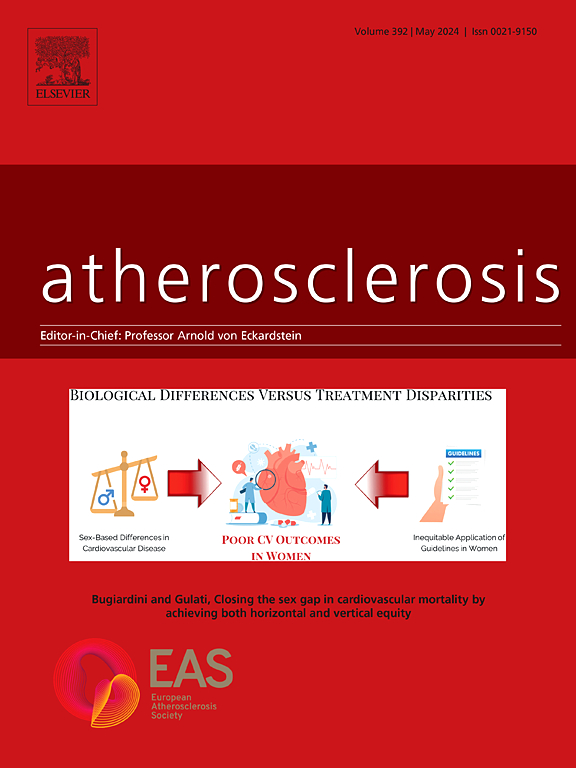中性粒细胞计数的种族差异作为急性心肌梗死后预后的预测因子
IF 4.9
2区 医学
Q1 CARDIAC & CARDIOVASCULAR SYSTEMS
引用次数: 0
摘要
目的中性粒细胞升高与急性心肌梗死(AMI)后预后不良有关,但尚不清楚种族是否影响中性粒细胞计数与预后之间的关系。我们的目的是描述急性心肌梗死后中性粒细胞的时间动态,并评估种族、中性粒细胞计数和急性心肌梗死后预后之间的相互作用。方法将2016 ~ 2023年连续出现AMI的患者根据中位中性粒细胞计数分为两组。种族被分为白人和其他民族的总和(被称为“少数民族”)。主要结局是住院死亡率,次要结局是60天死亡率。结果在我们对3062例AMI患者(76%为白人,24%为少数民族)的研究中,我们发现中性粒细胞计数在AMI后早期上升,这与其他细胞组的最低点相吻合。我们发现,与白人个体相比,少数民族个体的相对基线中性粒细胞减少(6.85 vs 8.42 × 109/L)。我们观察到基线中性粒细胞升高与院内死亡率的主要转归之间存在显著的独立关联(OR 2.06, p <;0.001)和60天全因死亡率的次要结局(HR 1.08, p = 0.002)。亚组分析显示,种族和中性粒细胞升高之间存在显著的相互作用(p = 0.004),表明中性粒细胞数量相当会增加少数民族患者两种结果的风险。结论:我们报告了AMI后种族特异性白细胞动力学。此外,与白人相比,中性粒细胞计数在少数民族中与不成比例的风险相关。了解ami后炎症及其与种族的相互作用对于提供个性化预后和患者管理至关重要。本文章由计算机程序翻译,如有差异,请以英文原文为准。

Ethnic variations in neutrophil count as predictors of prognosis following acute myocardial infarction
Aims
Elevated neutrophils are associated with a poor prognosis after acute myocardial infarction (AMI) but it is not known if ethnicity influences the association between neutrophil count and outcome. We aimed to describe the temporal dynamics of neutrophils after AMI, and assess the interaction between ethnicity, neutrophil count, and outcomes after AMI.
Methods
Consecutive patients presenting with AMI between 2016 and 2023 were divided into two groups according to their median neutrophil count. Ethnicity was dichotomised as white and other ethnic groups combined (referred to as ‘ethnic minorities’). The primary outcome was in-hospital mortality, with a secondary outcome of 60-day mortality.
Results
In our study of 3062 AMI patients (76 % white, 24 % from ethnic minority groups), we found that neutrophil counts rose early post AMI, which coincided with a nadir of the other cell groups. We identified a relative baseline neutropenia in ethnic minority individuals, compared to white individuals (6.85 vs 8.42 × 109/L). We observed a significant, independent association between elevated neutrophils at baseline and the primary outcome of in-hospital mortality (OR 2.06, p < 0.001) and secondary outcome of 60-day all-cause mortality (HR 1.08, p = 0.002). Sub-group analysis revealed a significant interaction between ethnicity and elevated neutrophils (p = 0.004), indicating that a comparable neutrophil count conferred an increased risk for ethnic minority patients for both outcomes.
Conclusions
We report ethnicity-specific leucocyte dynamics after AMI. Furthermore, neutrophil count is associated with a disproportionate risk in ethnic minority compared with white individuals. Understanding post-AMI inflammation and its interaction with ethnicity is essential in providing personalised prognostication and patient management.
求助全文
通过发布文献求助,成功后即可免费获取论文全文。
去求助
来源期刊

Atherosclerosis
医学-外周血管病
CiteScore
9.80
自引率
3.80%
发文量
1269
审稿时长
36 days
期刊介绍:
Atherosclerosis has an open access mirror journal Atherosclerosis: X, sharing the same aims and scope, editorial team, submission system and rigorous peer review.
Atherosclerosis brings together, from all sources, papers concerned with investigation on atherosclerosis, its risk factors and clinical manifestations. Atherosclerosis covers basic and translational, clinical and population research approaches to arterial and vascular biology and disease, as well as their risk factors including: disturbances of lipid and lipoprotein metabolism, diabetes and hypertension, thrombosis, and inflammation. The Editors are interested in original or review papers dealing with the pathogenesis, environmental, genetic and epigenetic basis, diagnosis or treatment of atherosclerosis and related diseases as well as their risk factors.
 求助内容:
求助内容: 应助结果提醒方式:
应助结果提醒方式:


